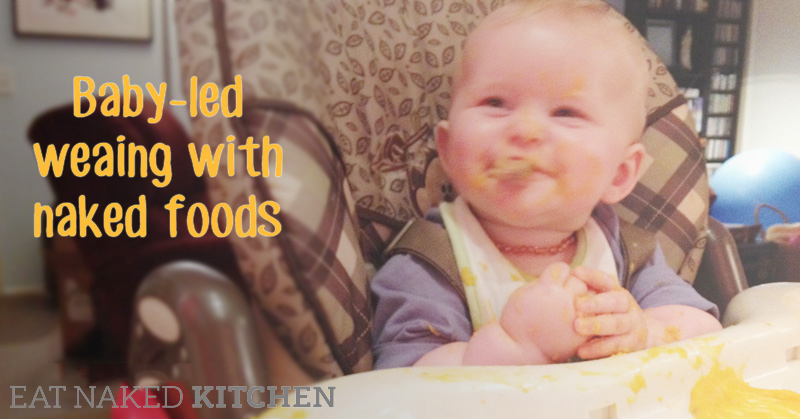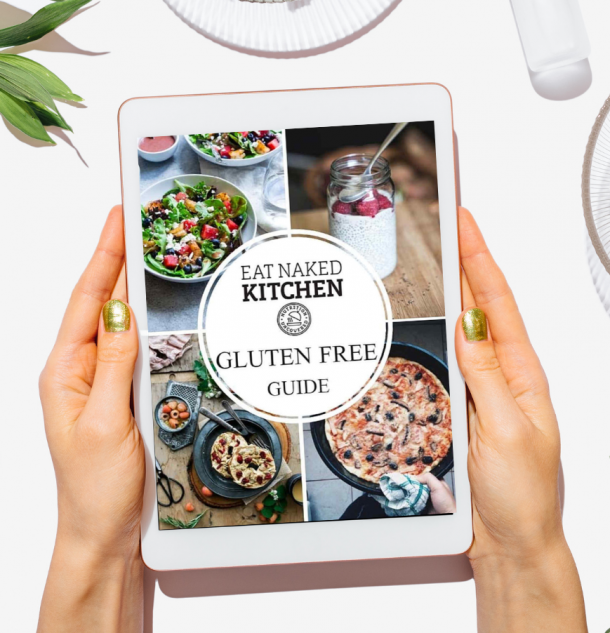*Please remember that you ALWAYS want to be supervising your children when they are just learning about food in this way. Never leave a baby with food unsupervised. Even without teeth, bits could break off and pose a choking hazard. Always use appropriate caution.
********************************************
Last week, we celebrated our baby girl’s six month birthday. An exciting day for lots of reasons, one of which is that she is now at that milestone that allows for the introduction of solid foods. Being extremely invested in protecting her still-developing digestive system and also in introducing her to foods in a way that inspires an adventurous and healthy eater, we’ve been researching different feeding methods. We recently learned about a new concept called “baby-led weaning,” a term coined by public health nurse and mother, Gill Rapley.
Baby-led weaning is all about letting your child lead the way with the introduction of solid foods.

Rather than pureeing up a storm and spoonfeeding your baby, you lay out several real (read: naked!) food options that the child can choose from, and let him do his thing. No pressure, no struggles, no big production. The child learns about food at a gradual place – at first just playing with and sucking on it to explore tastes and textures, gradually learning how to gum and chew on it, then moving the food to the back of the mouth, and eventually to swallowing.
Instinctively this makes a lot of sense to us. Developmentally we go through stages in learning to walk – why would it be different in learning to chew and eat?
This week, guest author Melinda Nelson, a myofunctional therapist and fellow nutritional therapy practitioner, shares some tips on how to introduce foods to your baby using this baby-led weaning process. If you’re intrigued and want to learn more, check out Gill Rapley’s book, Baby-Led Weaning: The essential guide to introducing solid foods and helping your baby grow up a happy and confident eater
_______________________
In the last couple of years there’s been a new idea floating around on how to introduce your baby to solid foods: baby-led weaning. Rather than pureeing and spoon-feeding your baby, you just add real food baby can grab and play with. Of course, you’re still breastfeeding or bottle-feeding formula at this point, so the baby is still getting most of her nourishment that route.
As an orofacial myologist, I see the effects of what incorrect swallowing habits can bring. It starts early, especially with the use of sippy cups and bottles. These feeding modes place the tongue lower in the mouth rather than the roof of the mouth as with breastfeeding. The child is more susceptible to mouth breathing as the lower jaw carries the weight of the tongue, making some muscles fatigued. Facial growth becomes impaired and later in life he may have what’s called “long face syndrome” along with crooked teeth and a narrow jaw.
So that’s enough on facial muscles, on to baby-led weaning.
The best time to start introducing solids is when the baby can begin to put food into her mouth by herself.
This is usually at about six months old. Four months is a bit early, although the baby is curious, they don’t understand what they’re seeing, such as Mommy and Daddy eating.
Here are some tips to get started
- Make sure the food is cooked, like carrots, and give them a large enough piece to hold on to. Leaving the skin on will help them to hold it without it sliding out of their hand.
- Babies can gnaw on bones and will get some nutrients from it but meat is a bit too hard for them to chew until they have teeth in the back. You might find that bones are good for teething.
- Always be in the room when the baby is eating. This is especially important if they have started with pureed foods and spoon-feeding which tends to teach baby to eat large bites because they don’t have to chew. Babies love to handle their food and have fun eating this way. It takes them longer to eat so they learn to enjoy their meal. They examine, feel, smell and taste their food discovering what they like and what they don’t like.
Make it easy and fun
- Easy first foods for baby are things like steamed or lightly boiled whole vegetables such as green beans, broccoli, cauliflower and snap peas.
- Roasted vegetables can be good to such as carrot, potato, sweet potato, parsnip, pumpkin, and zucchini.
- Raw cucumbers sliced and cooled in the refrigerator are soothing for babies who are teething.
- Of course avocado is good, just make sure it’s hard enough for them to hold
- You can include a strip of chicken or meat though they will gnaw on it until they have teeth. Just sucking out the juices will give them some important nutrients, even before they can chew and swallow it.
- You can get creative as you go with lentil patties and falafels or some meat nugget you make yourself.
- Don’t ever give them fast foods, packaged foods, or any food with added salt or sugar.
- You can add fruit, unflavored yogurt, grains, beans and cheese as you go.
Continue to breastfeed, as this is her main source of nutrients. Also, when you’re first starting out, make sure to breastfeed before you offer the solid foods so your child can first explore the food, as they won’t be so hungry. Remember, you won’t be putting food into their mouth or trying to persuade them to eat. They run the show.
As the baby learns to eat real foods keep in mind the nutrients they need just as you would for yourself. Offer a variety at each meal, and don’t fret if they only gravitate to certain foods. Keep offering and let them discover at their own pace. As they are able to eat more foods, they will play less and eat more out of hunger, gradually beginning to wean themselves of breast milk as their main meal. At this time don’t worry about how much they are eating, a baby will put the food into the front of the mouth to decide if they want it or not and may spit it out.
When we spoon feed our babies pureed foods, often we put too much into the mouth making them spit it out in order to swallow correctly. When we let the babies determine what and how much they can swallow at once, they continue the proper swallow from breast-feeding into whole foods. This is vital to the orofacial growth. It is baby led, remember! Eat dinner together and enjoy!
about the author: Melinda Nelson is a myofunctional therapist and an NTP. After a career in dental hygiene she became interested in nutrition and breathing as a Buteyko Breathing Practitioner. web: Orofacialmyologyoforangecounty.com email: Blessd2be2@yahoo.com





I know about BLW from a guide I read and got really interested in this approach so now I’m reading everything over the internet. Thanks for the article!
Babies should never have bones. They can splinter and choke baby.
Hi Ann, if you talk to any baby led weaning parent they will tell you that isn’t true. First, the bones that you would let a child gnaw on it, are too big and don’t splinter like tiny bones. Second, the 6 mos old child is still gumming the meat/bone. Their jaws aren’t strong enough to splinter a large bone. Third, to your point, no one should ever feed a child meat with a small bone because as you say, it could get lodged in their throat. Thanks for your comment and for allowing us to clarify.